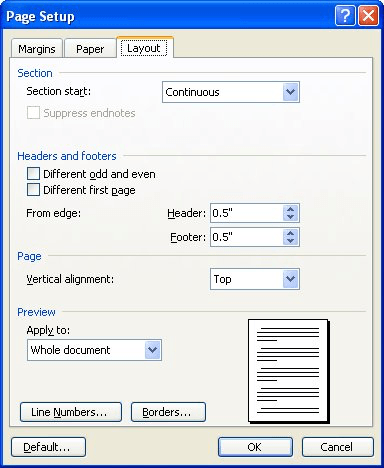Please Note: This article is written for users of the following Microsoft Word versions: 97, 2000, 2002, and 2003. If you are using a later version (Word 2007 or later), this tip may not work for you. For a version of this tip written specifically for later versions of Word, click here: Starting a New Section on an Odd Page Number.
Written by Allen Wyatt (last updated January 1, 2022)
This tip applies to Word 97, 2000, 2002, and 2003
When writing a document that is divided into sections or chapters, it is not unusual to have each new chapter or section start on an odd-numbered page. Word makes it very easy to accommodate this need when you are creating a document. You control this through the use of sections. All you need to do is create a new document section whenever you want to start a new chapter in your document. Follow these steps:

Figure 1. The Break dialog box.
Anything that is typed immediately after the section break will appear on an odd-numbered page when printed. If necessary, Word inserts a blank page between information in the previous section and the information in the new section to achieve this directive.
If you already have your document divided into sections (you have already inserted section breaks, in other words), you can make sure that a section will start on an odd-numbered page by following these steps:

Figure 2. The Layout tab of the page Setup dialog box.
WordTips is your source for cost-effective Microsoft Word training. (Microsoft Word is the most popular word processing software in the world.) This tip (634) applies to Microsoft Word 97, 2000, 2002, and 2003. You can find a version of this tip for the ribbon interface of Word (Word 2007 and later) here: Starting a New Section on an Odd Page Number.

Create Custom Apps with VBA! Discover how to extend the capabilities of Office 365 applications with VBA programming. Written in clear terms and understandable language, the book includes systematic tutorials and contains both intermediate and advanced content for experienced VB developers. Designed to be comprehensive, the book addresses not just one Office application, but the entire Office suite. Check out Mastering VBA for Microsoft Office 365 today!
Document backgrounds come in handy if you plan on converting the document to a Web page. Here's how you can add a ...
Discover MoreThe Page Setup dialog box is indispensable in setting up the overall look of your document. You can display the dialog ...
Discover MoreWord allows you to change the character of how your pages are designed by using multiple sections in a document. If you ...
Discover MoreFREE SERVICE: Get tips like this every week in WordTips, a free productivity newsletter. Enter your address and click "Subscribe."
There are currently no comments for this tip. (Be the first to leave your comment—just use the simple form above!)
Got a version of Word that uses the menu interface (Word 97, Word 2000, Word 2002, or Word 2003)? This site is for you! If you use a later version of Word, visit our WordTips site focusing on the ribbon interface.
Visit the WordTips channel on YouTube
FREE SERVICE: Get tips like this every week in WordTips, a free productivity newsletter. Enter your address and click "Subscribe."
Copyright © 2026 Sharon Parq Associates, Inc.
Comments